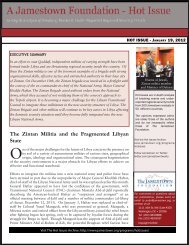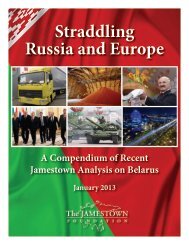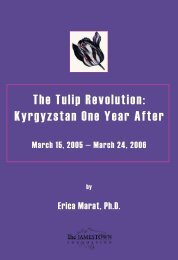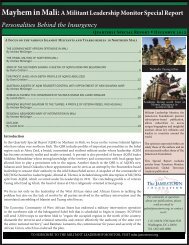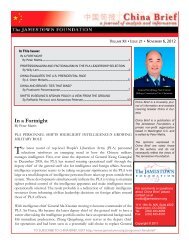By Brian Glyn Williams - The Jamestown Foundation
By Brian Glyn Williams - The Jamestown Foundation
By Brian Glyn Williams - The Jamestown Foundation
You also want an ePaper? Increase the reach of your titles
YUMPU automatically turns print PDFs into web optimized ePapers that Google loves.
oth the Russians and Cossacks who presented a threat to the Khanate's interests as well as the Sultans.<br />
<strong>The</strong> Crimean Khans and mirzas (chieftains) were usually more than willing to participate in joint<br />
missions against their traditional steppe enemies.<br />
<strong>The</strong> enthusiastic attitude of the Crimea's leadership combined with the Tatars' steppe skills to render<br />
their assistance against the Ottomans' steppe foes more effective here than on the plains of Hungary or<br />
the valleys of the Caucasus.<br />
It must be noted that the Tatars were aided on this front by the nature of the steppe. <strong>The</strong> vast<br />
waterless expanses of this region suited the Tatars' methods of warfare far more than the Western tactics<br />
which Russia began to adopt during the reign of Ivan the Terrible. <strong>The</strong> orderly formations of foot-soldiers<br />
that dominated the battlefields of Western Europe were ineffective on the open steppe where the Khan's<br />
horsemen could destroy slow moving baggage trains, cut off supply convoys and burn the grasslands<br />
to hinder progress. Cannons were also rarely used on the steppe for the heavy artillery of the age was<br />
too awkward to be used against the elusive Tatar riders until the late seventeenth century.<br />
Although the Russians did use artillery and Western style formations when fighting the Swedes, Livonians<br />
and Poles, they were forced to imitate the Tatars' mode of combat when fighting on their southern borders. In<br />
consequence, the Russian cavalryman, armed with a bow and saber, differed little from his Tatar<br />
adversary. <strong>The</strong> following description of Ivan the Terrible's warriors shows how strongly the Tatars<br />
influenced their northern neighbor's cavalry.<br />
All his men are horsemen. He useth no foot soldiers but such as go with the<br />
ordinance or labourers. <strong>The</strong> horsemen are all archers with such bows as the Turks have,<br />
and they ride short as do the Turks. <strong>The</strong>ir armor is a coat of plate with a skull on their<br />
heads. Some of their coats are covered with velvet or cloth of fold. <strong>The</strong>ir desire is to be<br />
sumptuous in the field.<br />
Although the Tsar's warriors did adapt admirably to the conditions of the steppe, their equine skills<br />
never matched those of the Tatars. <strong>The</strong> Khan's horsemen, who considered riding to be more than<br />
just a part-time occupation, were usually able to outride the Tsar's less capable cavalry as this seventeenth<br />
century account clearly shows. According to this observation, the Russians:<br />
retire to certain rivers and woods to prevent their passage. But the Tatar is an enemy so light<br />
and dexterous that he understands this, and amuses the Muscovite army with 20-30,000<br />
horses, meanwhile sending a number of people to raid the land by some other way, which<br />
is done with such promptness that they have dealt their blow before the Muscovites<br />
know of it. 74<br />
<strong>The</strong> Crimean Tatar's contributions on the steppe were once again not without a negative side. Many of the<br />
problems with the Tatars on the northern front stemmed from the fact that the Crimean Khans had political<br />
aspirations of their own on the steppe; most of which did not coincide with those of the Porte. <strong>The</strong> Crimean<br />
Khan's independent attempts to reunite the Khanates of Kazan and Astrakhan under Crimean authority posed<br />
a threat to the Ottoman control over the river basins of the Ukraine. <strong>The</strong> Ottomans feared that a reunited<br />
Golden Horde might not be as friendly or complacent in its dealings with the Ottoman Empire. On at least<br />
one occasion, the Astrakhan Expedition of 1571, historians have accused the Crimean Tatars of<br />
deliberately sabotaging an Ottoman mission for fear that its success would weaken the Khanate's<br />
20






